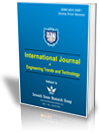Deep Learning Approach for Diagnosing Papulosquamous Disease
Deep Learning Approach for Diagnosing Papulosquamous Disease |
||
 |
 |
|
| © 2025 by IJETT Journal | ||
| Volume-73 Issue-3 |
||
| Year of Publication : 2025 | ||
| Author : G. Nagarajan, Arun Raaza, Chetna Dayanand Achar, M. Meena |
||
| DOI : 10.14445/22315381/IJETT-V73I3P105 | ||
How to Cite?
G. Nagarajan, Arun Raaza, Chetna Dayanand Achar, M. Meena, "Deep Learning Approach for Diagnosing Papulosquamous Disease," International Journal of Engineering Trends and Technology, vol. 73, no. 3, pp. 58-72, 2025. Crossref, https://doi.org/10.14445/22315381/IJETT-V73I3P105
Abstract
The six papulosquamous skin diseases, including psoriasis, psoriatic arthritis, eczema, and dermatitis, can be difficult to diagnose and treat due to their similar clinical manifestations. Diseases of the skin can be caused by a combination of environmental and genetic factors, and their consequences can be devastating. Developing early and automatic skin disease predictions is essential to reduce the dermatologist’s workload and enhance treatment outcomes. This study uses the Xiangya-Derma knowledge-based clinical image database in order to gain a greater understanding of skin diseases. A complex deep neural network is trained from the images in the dataset to extract the affected area adaptively. Numerous statistical characteristics are extracted and analyzed using the NDL method. The classifier uses a training procedure and a number of stacked “layers” to recognize skin disease indicators. The effectiveness of the Python-implemented system under discussion was evaluated using a variety of performance metrics. In this research, 70% of the data was used for training, 20% for testing, and 10% for validation.
Keywords
Papulosquamous, China’s largest clinical image dataset, Adaptive optimized convoluted deep neural network, Neuroevolution deep learning.
References
[1] Kyungsu Lee et al., “Multi-Task and Few-Shot Learning-Based Fully Automatic Deep Learning Platform for Mobile Diagnosis of Skin Diseases,” IEEE Journal of Biomedical and Health Informatics, vol. 27, no. 1, pp. 176-187, 2023.
[CrossRef] [Google Scholar] [Publisher Link]
[2] S. Gopalakrishnan, Abishek B. Ebenezer, and A. Vijayalakshmi, “An Erythemato Squamous Disease (ESD) Detection Using DBN Technique,” 2022 International Conference on Communication, Computing and Internet of Things (IC3IoT), Chennai, India, pp. 1-4, 2022.
[CrossRef] [Google Scholar] [Publisher Link]
[3] Guanghui Yue et al., “Toward Multicenter Skin Lesion Classification Using Deep Neural Network with Adaptively Weighted Balance Loss,” IEEE Transactions on Medical Imaging, vol. 42, no. 1, pp. 119-131, 2023.
[CrossRef] [Google Scholar] [Publisher Link]
[4] SajaSalim Mohammed, and Jamal Mustafa Al-Tuwaijari, “Skin Disease Classification System Based on Machine Learning Technique: A Survey,” IOP Conference Series: Materials Science and Engineering: 2nd International Scientific Conference of Engineering Sciences, Diyala, Iraq, vol. 1076, no. 1, pp. 1-13, 2021.
[CrossRef] [Google Scholar] [Publisher Link]
[5] Bronwyn Shirley et al., “Radiation Therapy in the Adjuvant Treatment of Hyperkeratotic Palmoplantar Psoriasis: A Case Study,” Journal of Medical Radiation Sciences, vol. 68, no. 3, pp. 326-331, 2021.
[CrossRef] [Google Scholar] [Publisher Link]
[6] Caihe Liao et al., “Combination Curettage and Modified Ala-Pdt for Multiple Basal Cell Carcinomas of the Face and Head,” Photodiagnosis and Photodynamic Therapy, vol. 35, 2021.
[CrossRef] [Google Scholar] [Publisher Link]
[7] Gulsen Akoglu, et al., “Disease Severity and Poor Mental Health are the Main Predictors of Stigmatization in Patients with Hidradenitis Suppurativa,” Dermatologic Therapy, vol. 34, no. 3, 2021.
[CrossRef] [Google Scholar] [Publisher Link]
[8] Andre Esteva et al., “Deep Learning-Enabled Medical Computer Vision,” NPJ Digital Medicine, vol. 4, no. 1, pp. 1-9, 2021.
[CrossRef] [Google Scholar] [Publisher Link]
[9] Shuwei Shen et al., “Low-Cost and High-Performance Data Augmentation for Deep-Learning-Based Skin Lesion Classification,” Arxiv, pp. 1-8, 2021.
[CrossRef] [Google Scholar] [Publisher Link]
[10] Evgin Goceri, “Diagnosis of Skin Diseases in the Era of Deep Learning and Mobile Technology,” Computers in Biology and Medicine, vol. 134, 2021.
[CrossRef] [Google Scholar] [Publisher Link]
[11] Adekanmi Adegun, and SerestinaViriri, “Deep Learning Techniques for Skin Lesion Analysis and Melanoma Cancer Detection: A Survey of State-Of-The-Art,” Artificial Intelligence Review, vol. 54, pp. 811-841, 2021.
[CrossRef] [Google Scholar] [Publisher Link]
[12] Melina Tziomaka, “Classifying Melanoma Images with Ensembles of Deep Convolutional Neural Networks,” Master’s Thesis, University of Piraeus, 2021.
[Google Scholar]
[13] Gabriela Ribeiro de Araújo et al., “Leiomyoma and Leiomyosarcoma (Primary and Metastatic) Of the Oral and Maxillofacial Region: A Clinicopathological and Immunohistochemical Study of 27 Cases,” Head and Neck Pathology, vol. 16, pp. 294-303, 2021.
[CrossRef] [Google Scholar] [Publisher Link]
[14] Peng Yao et al., “Single Model Deep Learning on Imbalanced Small Datasets for Skin Lesion Classification,” Arxiv, pp. 1-13, 2021.
[CrossRef] [Google Scholar] [Publisher Link]
[15] Rania Ramadan, and Saleh Aly, “CU-Net: A New Improved Multi-Input Color U-Net Model for Skin Lesion Semantic Segmentation,” IEEE Access, vol. 10, pp. 15539-15564, 2022.
[CrossRef] [Google Scholar] [Publisher Link]
[16] Fengying Xie et al., “Skin Lesion Segmentation Using High-Resolution Convolutional Neural Network,” Computer Methods and Programs in Biomedicine, vol. 186, 2020.
[CrossRef] [Google Scholar] [Publisher Link]
[17] Jianxiao Bian et al., “Skin Lesion Classification by Multi-View Filtered Transfer Learning,” IEEE Access, vol. 9, pp. 66052-66061, 2021.
[CrossRef] [Google Scholar] [Publisher Link]
[18] SeungSeog Han et al., “Classification of the Clinical Images for Benign and Malignant Cutaneous Tumors Using a Deep Learning Algorithm,” Journal of Investigative Dermatology, vol. 138, no. 7, pp. 1529-1538, 2018.
[CrossRef] [Google Scholar] [Publisher Link]
[19] Li-sheng Wei, Quan Gan, and Tao Ji, “Skin Disease Recognition Method Based on Image Color and Texture Features,” Computational and Mathematical Methods in Medicine, vol. 2018, no. 1, pp. 1-10, 2018.
[CrossRef] [Google Scholar] [Publisher Link]
[20] Sourav Kumar Patnaik et al., “Automated Skin Disease Identification Using Deep Learning Algorithm,” Biomedical and Pharmacology Journal, vol. 11, no. 3, pp. 1429-1437, 2018.
[CrossRef] [Google Scholar] [Publisher Link]
[21] Parvathaneni Naga Srinivasu et al., “Classification of Skin Disease Using Deep Learning Neural Networks with Mobilenet V2 and LSTM,” Sensors, vol. 21, no. 8, pp. 1-27, 2021.
[CrossRef] [Google Scholar] [Publisher Link]
[22] Zhe Wu et al., “Studies on Different CNN Algorithms for Face Skin Disease Classification Based on Clinical Images,” IEEE Access, vol. 7, pp. 66505-66511, 2019.
[CrossRef] [Google Scholar] [Publisher Link]
[23] Tri-Cong Pham et al., “Improving Skin-Disease Classification Based on Customized Loss Function Combined With Balanced Mini-Batch Logic and Real-Time Image Augmentation,” IEEE Access, vol. 8, pp. 150725-150737, 2020.
[CrossRef] [Google Scholar] [Publisher Link]
[24] Belal Ahmad et al., “Discriminative Feature Learning for Skin Disease Classification Using Deep Convolutional Neural Network,” IEEE Access, vol. 8, pp. 39025-39033, 2020.
[CrossRef] [Google Scholar] [Publisher Link]
[25] Yanyang Gu et al., “Progressive Transfer Learning and Adversarial Domain Adaptation for Cross-Domain Skin Disease Classification,” IEEE Journal of Biomedical and Health Informatics, vol. 24, no. 5, pp. 1379-1393, 2020.
[CrossRef] [Google Scholar] [Publisher Link]
[26] Peng Tang et al., “GP-CNN-DTEL: Global-Part CNN Model With Data-Transformed Ensemble Learning for Skin Lesion Classification,” IEEE Journal of Biomedical and Health Informatics, vol. 24, no. 10, pp. 2870-2882, 2020.
[CrossRef] [Google Scholar] [Publisher Link]
[27] Jufeng Yang et al., “Self-Paced Balance Learning for Clinical Skin Disease Recognition,” IEEE Transactions on Neural Networks and Learning Systems, vol. 31, no. 8, pp. 2832-2846, 2020.
[CrossRef] [Google Scholar] [Publisher Link]
[28] Anuj Kumar Singh et al., “A Proportional Sentiment Analysis of MOOCs Course Reviews Using Supervised Learning Algorithms,” International Information and Engineering Technology Association, vol. 26, no. 5, pp. 501-506, 2021.
[CrossRef] [Google Scholar] [Publisher Link]
[29] Shashi Bhushan et al., “A Novel Approach to Face Pattern Analysis,” Electronics, vol. 11, no. 3, pp. 1-14, 2022.
[CrossRef] [Google Scholar] [Publisher Link]
[30] Shashi Bhushan et al., “An Experimental Analysis of Various Machine Learning Algorithms for Hand Gesture Recognition,” Electronics, vol. 11, no. 6, pp. 1-15, 2022.
[CrossRef] [Google Scholar] [Publisher Link]
[31] Vimal K. Shrivastava et al., “Reliability Analysis of Psoriasis Decision Support System in Principal Component Analysis Framework,” Data and Knowledge Engineering, vol. 106, pp. 1-17, 2016.
[CrossRef] [Google Scholar] [Publisher Link]
[32] Vimal K. Shrivastava et al., “Computer-Aided Diagnosis of Psoriasis Skin Images with HOS, Texture and Color Features: A First Comparative Study of its Kind,” Computer Methods and Programs in Biomedicine, vol. 126, pp. 98-109, 2016.
[CrossRef] [Google Scholar] [Publisher Link]
[33] Fujia Ren, Chenhui Yang, and Y.A. Nanehkaran, “MRI-Based Model for MCI Conversion Using Deep Zero-Shot Transfer Learning,” The Journal of Supercomputing, vol. 79, pp. 1182-1200, 2023.
[CrossRef] [Google Scholar] [Publisher Link]
[34] Y.A. Nanehkaran et al., “Analysis and Comparison of Machine Learning Classifiers and Deep Neural Networks Techniques for Recognition of Farsi Handwritten Digits,” The Journal of Supercomputing, vol. 77, pp. 3193-3222, 2021.
[CrossRef] [Google Scholar] [Publisher Link]
[35] Md. Kowsher et al., “LSTM-ANN and BiLSTM-ANN: Hybrid Deep Learning Models for Enhanced Classification Accuracy,” Procedia Computer Science, vol. 193, pp. 131-140, 2021.
[CrossRef] [Google Scholar] [Publisher Link]
[36] Y.A. Nanehkaran et al., “A Pragmatic Convolutional Bagging Ensemble Learning for Recognition of Farsi Handwritten Digits,” The Journal of Supercomputing, vol. 77, pp. 13474-13493, 2021.
[CrossRef] [Google Scholar] [Publisher Link]

